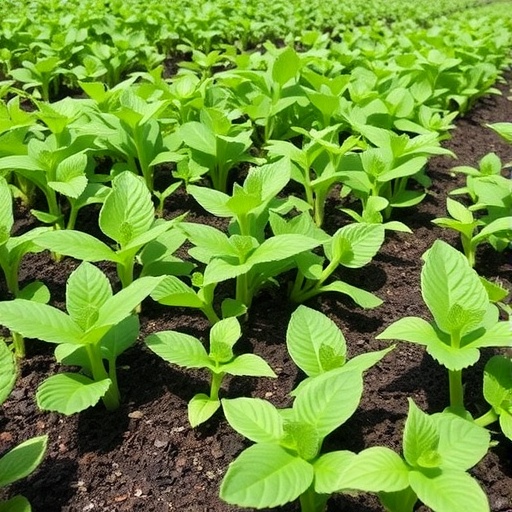In recent years, the impact of heavy metal pollution on agricultural productivity has garnered considerable attention. Among these pollutants, cadmium (Cd) presents a significant threat to plant growth and soil health, adversely affecting both crop yield and soil quality. The ongoing search for sustainable agricultural practices and methods to ameliorate the adverse effects of such pollutants has led researchers to explore the potential of beneficial microorganisms. A groundbreaking study conducted by Sojoudi et al. has demonstrated the promising effects of two such microorganisms, Ensifer meliloti and Rhizophagus intraradices, on alfalfa’s growth indices when faced with cadmium sulfide nanoparticle stress.
The study is an essential step forward in understanding how plant-microbe interactions can mitigate the physical and physiological stress that plants experience under heavy metal exposure. The authors conducted comprehensive experiments with alfalfa, a widely cultivated forage legume known for its high nutritional value and ability to improve soil quality. Through this research, they provided compelling evidence of how microbial symbionts can enhance plant resilience against environmental stressors, opening new avenues for sustainable agriculture.
The primary focus of this research was to investigate the potential protective effects of Ensifer meliloti and Rhizophagus intraradices on alfalfa plants suffering from cadmium sulfide stress. Both microorganisms play crucial roles in nutrient uptake and enhancement of plant growth; however, their combined effect in combating cadmium toxicity has not been widely studied until now. By evaluating various growth indices of alfalfa plants subjected to varying concentrations of cadmium nanoparticles, the researchers sought to determine the extent to which these beneficial organisms could alleviate stress in these crops.
Cadmium, a ubiquitous environmental contaminant, negatively affects plant physiology and growth by disrupting essential physiological processes. It competes with vital nutrients such as calcium and magnesium, leading to nutrient imbalances that severely impair plant health. Additionally, cadmium promotes oxidative stress in plants, causing the generation of reactive oxygen species (ROS). The authors noted that the introduction of beneficial microorganisms could help mitigate these harmful effects.
In this elaborate study, the seedlings of alfalfa were inoculated with Ensifer meliloti and Rhizophagus intraradices before being subjected to cadmium sulfide nanoparticle treatment. Notably, the effects on growth parameters such as plant height, fresh weight, dry weight, and chlorophyll content were meticulously recorded and analyzed. The authors were particularly interested in quantifying the improvement in growth indices among the treated plants relative to the control group exposed to cadmium without microbial treatment.
The data obtained from the experiments revealed a remarkable increase in the growth indices of alfalfa plants inoculated with these microorganisms in comparison to those that were not treated. The plants exhibited enhanced chlorophyll content and overall biomass accumulation, highlighting the synergistic relationship between the plants and the microorganisms. The roots of the treated plants showed significant improvements in biomass, suggesting that both Ensifer meliloti and Rhizophagus intraradices aid in better nutrient absorption even under cadmium stress.
Furthermore, the study delved into the biochemical changes occurring in alfalfa plants under the influence of these microorganisms amidst heavy metal exposure. The microbial inoculation resulted in a marked reduction in oxidative stress markers compared to non-inoculated plants. This reduction is a vital finding, as it emphasizes the ability of these microbes to enhance plant antioxidant systems, ultimately leading to improved resilience against cadmium toxicity.
In addition to discussing the biochemical interactions, the researchers also explored the potential mechanisms behind the observed growth benefits. They indicated that the symbiotic relationships established between the roots of alfalfa and the microorganisms are critical. The endophytic properties of Ensifer meliloti facilitate nitrogen fixation, which is essential in supporting plant metabolic processes, while mycorrhizal networking provided by Rhizophagus intraradices enhances phosphorus and micronutrient uptake.
The authors pointed out that incorporating these microorganisms into agricultural practices could provide a dual benefit. Not only could they mitigate the harmful effects of cadmium pollution, but they could also enhance the overall nutritional profile of crops, leading to better health outcomes for livestock and humans alike. This highlights significant implications for sustainable agriculture, especially in regions heavily impacted by heavy metal contamination.
In conclusion, the study conducted by Sojoudi et al. sheds light on the profound implications of microbial interactions in enhancing plant growth under environmental stress. By demonstrating the efficacy of Ensifer meliloti and Rhizophagus intraradices in counteracting the adverse effects of cadmium sulfate nanoparticles on alfalfa, the researchers opened new avenues for employing biotechnology in agriculture. As global challenges surrounding environmental pollution continue to escalate, such research underscores the importance of sustainable practices in maintaining agricultural productivity and soil health.
Ultimately, navigating the complexities of plant resilience in the face of rising environmental contaminants is essential for the future of global food security. As researchers continue to unveil the multifaceted relationships between plants and beneficial microbes, the potential for developing innovative solutions becomes increasingly apparent. With insights derived from this study, the agricultural community may embrace biotechnological advancements to safeguard crops while addressing the challenges posed by an evolving environment.
This pioneering research not only contributes to the existing body of knowledge surrounding heavy metal stress in plants but also emphasizes the critical role that beneficial microbes could play in shaping the future of sustainable agriculture. As we continue to explore these dynamic relationships, it is anticipated that innovative approaches will emerge, paving the way toward resilient food systems capable of withstanding the pressures of pollution and climate change.
Subject of Research: The interaction between beneficial microorganisms and alfalfa plants under cadmium sulfide nanoparticle stress.
Article Title: Effects of Ensifer meliloti and Rhizophagus intraradices on alfalfa growth indices under cadmium sulfide nanoparticle stress.
Article References:
Sojoudi, A., SoltaniToularoud, A., GoliKalanpa, E. et al. Effects of Ensifer meliloti and Rhizophagus intraradices on alfalfa growth indices under cadmium sulfide nanoparticle stress. Environ Sci Pollut Res (2025). https://doi.org/10.1007/s11356-025-37132-6
Image Credits: AI Generated
DOI: 10.1007/s11356-025-37132-6
Keywords: Cadmium sulfide, Alfalfa, Ensifer meliloti, Rhizophagus intraradices, Heavy metals, Plant growth, Sustainable agriculture.




